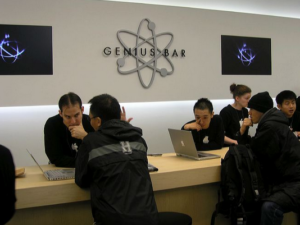We live in the age of digital disruption – a time when organizations are challenged to transform . . . Or die. That’s not an overstatement in an era where household brands are both materializing and

disappearing on a near-daily basis. Technology is advancing at a mind-boggling pace, and innovative businesses are launching all the time, each raising the bar on consumer expectations just a tad higher. Think about this … you can be disrupted, or you can seek to achieve a shockingly 3M disruptive innovation for your business.
Creativity is thinking up new things; innovation is doing new things. Especially disruptive innovation.
Good innovators are often the smartest guys in the room. Through years of experience solving tough problems, they learn to be masters of their craft and are able to mentor those around them. A great operational manager is a great coach, guiding others around them to achieve more than they thought they could.
Unfortunately, innovation isn’t about what you know, but what you don’t. It requires you to explore, push boundaries and venture into uncharted areas in which there often are no true experts. You’re basically flying blind, which can be incredibly uncomfortable, especially to those who have had a strong track record of success in a structured environment.
That’s why the first step to making the shift from operations to innovation is to learn how to become the dumbest guy in the room instead of the smartest. Admit to yourself that you don’t know what you need to succeed and begin to explore. Actively seek out those who know and understand things that you don’t.
Being the smartest guy in the room helps you operate smoothly, but being the dumbest guy in the room helps you learn. The best way to start is by seeking out new rooms to spend time in.
The average company is massively challenged by the demand for near-constant transformation. No businesses will be exempt, not even the smallest of the small.
The trickle-down effect is always in play, even if you hear little about the impact on these guys.
The forces of digital disruption are radically altering how we all access and consume information, communicate and socialize, shop and purchase.
Ubiquitously connected devices, social networks, cloud services – these and other innovations have already essentially inverted the relationship between sellers and buyers, between brands and customers.
Consumers are empowered by information and shared opinions, and they are emboldened by choice. They have developed an appetite for rich and rewarding interactions, and they rarely hesitate to seek alternatives when disappointed.
Related: Does a Paradox on Innovation Design and Creativity Exist in Business?
We often think of innovation as inventing new things, but we may be smarter to think of it as recombining old ones.
The truth is that significant breakthroughs usually come from combining ideas from different domains. Often very different, sometimes weird ideas.
Increasingly, companies will succeed and fail according to the quality of the digital experiences that they offer. So why wait?
Go after the shockingly disruptive innovation for your business. Let’s discuss how you could achieve this goal.
3M disruptive innovation … begin with a small problem
Peter Drucker once wrote, “Effective innovations start small. They are not grandiose.” He was spot on.
Take a look at any big thing and, inevitably, it’s modest origins. Microsoft became one of the world’s most valuable companies by focusing on software, an area so inconsequential at the time that IBM was willing to write it off.
Apple made a splash with the Macintosh to a significant part by capitalizing on innovations that Xerox tossed aside.
The great thing about thinking small is that you can risk failure because failure is sustainable. You can falter, pick yourself up and try again.
Eventually, you’ll get it right, and when you do, there are no limits. If you can survive, you can thrive.

3M disruptive innovation … problem-based on customer input
Zara is one of the greatest examples of process innovation.
The founder, Armancio Ortega started his business in the year 1975 as a single store in La Coruña (Spain). Ortega, once a tailor’s assistant learned the value of controlling all steps of the production and distribution process, later he applied it all to the Zara chain.
And started refining the process steps based on this critical concept.
Every day, store managers report customer feedback information to headquarters, where it is then transmitted to a huge team of in-house designers, who quickly develop new designs and send them to factories to be turned into clothes.
Echevarría said that is because the customer is always determining production — not the other way around. An interesting thought isn’t it?
Every piece of clothing the company makes has, in a way, been requested. A business model that is so closely attuned to the customer does not share the cycle of a financial crisis.
3M disruptive innovation … collect and leverage observed data
Most leaders demand hard data when making critical decisions. In times of disruptive change, robust data rarely exist. Leaders must use any information they can obtain from any source inside and outside the company—but then complement that data by using their gut to round out the equation.
Read books and magazines, and watch videos and presentations on topics you wouldn’t normally. Attend conferences in seemingly unrelated fields. Pay attention to products or company ideas coming from other countries and other fields.
3M disruptive innovation … look for latent desires
Steve Jobs was a big believer in hidden desires in customers … clients who couldn’t tell you what they wanted. A great example comes from the Apple ecosystem.
There were plenty of digital music players around when Steve Jobs and Apple launched the iPod. Note he also combined his player with iTunes, which made content both more accessible and palatable to music companies.
He then threw new products into the mix – the iPhone, iPad and now Siri – creating more combinations and even greater value.
Connect the disconnected
While we like to think of innovators being lonely men on the mountain, only coming down, like Nietzsche’s Zarathustra, to proclaim great revelations, the truth is that significant breakthroughs usually come from synthesizing ideas from different domains.
One famous historical example is that of the discovery of genetics. In 1865, when Gregor Mendel published his groundbreaking study of inheritance of characteristics in pea plants, it went nowhere.
It had taken nearly a half-century before the concept was combined with Darwin’s natural selection to unleash a torrent of innovations in medicine and science.

3M disruptive innovation …
focus on adding value
Business models are often neglected when considering new ideas for your business. They shouldn’t be. One of the best examples of an innovative business model is from Safelite Auto Glass.
What’s innovative here you may be thinking? It’s simple. An auto glass repairs business that comes to you for your repair. Saving you time and convenience.
A value proposition and business model that is hard to top.
Another good example is eBay, reflecting a new design and application of supply, demand, and sales.
Technology Disruption: Behind the Scenes of a On-coming Problem
3M disruptive innovation … look at things in a new way
Disruptive innovation and change is a process chock full of surprise—failures, successes, unexpected technological advancements, aggressive moves, customer feedback, political and regulatory shifts, and other unforeseen events. Most leaders assume surprises always should be avoided.
But those who realize that surprises are an inevitable part of a business (just like life) are best equipped to use surprise as a strategic tool—which makes them the agilest and fastest to respond to or capitalize on unforeseen events.
Sustaining innovation … shift ideas into a new context
A simple example of this is the use of milk cartons to display missing persons’ picture and description details. Can you imagine a better place to get this kind of attention?
3M disruptive innovation … examine what can be changed
Ask employees for ideas and remember no idea is unworthy of consideration. Your employees see opportunities every day for saving money or doing things better.
Ask for their thoughts. At the U.S. Postal Service, 850 employee-led “Green Teams” helped save $52 million related to water, energy, fuel, and waste and generated $24 million in new revenue through recycling.
The next big thing always starts out looking like nothing at all. If it was easy to see coming, everybody would be doing it already and the market impact would be minimal. So you can never create something truly new based on what you already know. The only way to find it is to start looking.
Not all who wander are lost. The trick is to wander with a purpose.
Key takeaways
Our message for businesses is simple. Think more like an innovator.
Learn the innovation process. Spend time at the front end on what the marketplace needs, rather than trying to build a slick marketing campaign selling your invention.
That is the best way to success.
Innovation isn’t about talking; it’s about doing. The action. So get moving and begin your journey from accidental innovator to a high-performance innovation business leader.
Like anything else, fostering creative business ideas require practice. So exercise and practice this skill and utilize it in as many areas of your business as you can.
